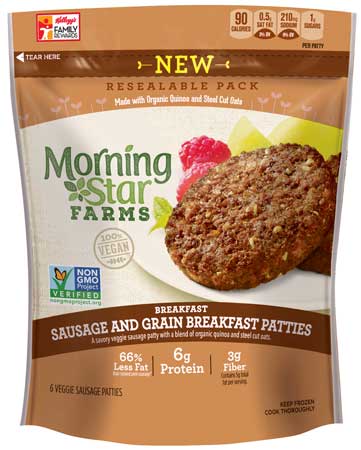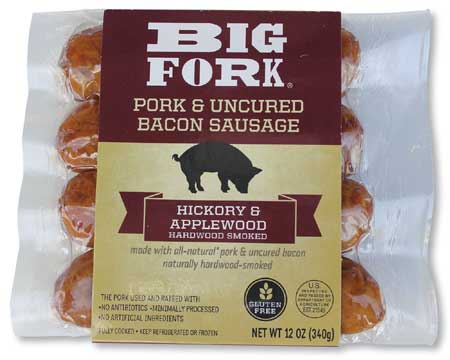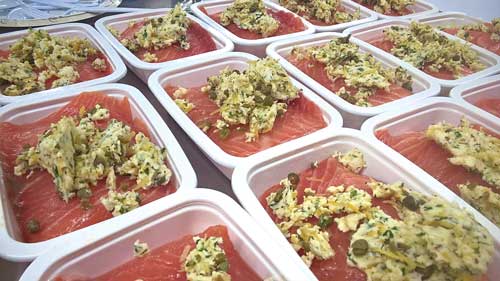Packaging Solutions for Clean Label Products
PACKAGING
Food retailers, manufacturers, and producers are enacting clean label guidelines. The term “clean label” is not uniformly defined, but it usually implies that there are no added artificial preservatives, flavors, colors, binding agents, and often, other specific ingredients. Removing ingredients intended to preserve food safety and quality while maintaining equivalent shelf life places new demands on packaging technologies. Active packaging and entwined package and post-processing solutions play vital roles in providing shelf life for clean label products. In fact, freezing, active packaging, microwave-assisted pasteurization systems (MAPS), and other technologies are being used to extend the shelf life of clean label products, and they demand refined packaging solutions.
Freezable Packaging
The removal of sorbates and other additives in clean label bakery products shortens the time frame for mold growth from 7–10 days to 2–5 days. Freezing can decrease the rates of many deteriorative reactions in foods, and freezing clean label (and conventional) bread results in a shelf life extension of about six months. Frozen distribution and ambient retail constitute one method used for clean label products to yield desired shelf life. But when packaged products are placed in freezers, package properties can change due to inherent glass transition temperatures (Tg).
 The most significant changes due to low temperature exposure are seen in polymers and polymer-based adhesives. For example, because the Tg of polypropylene is well above freezing temperatures, polypropylene is crystalline at freezing temperatures and becomes extremely brittle. This results in the tearing of polypropylene films, loss of seal integrity, and containers breaking during distribution and handling. Polypropylene is commonly used for clear package windows, such as bread wrap and hot-fill sauce containers. When these products are frozen, they also often expand due to moisture, so alternative package materials and structural redesign are often needed. One solution is to blend polyethylene into polypropylene-based containers and film to create freezer-grade polypropylene and employ panels that allow for containers to expand. The addition of polyethylene, however, results in a hazy appearance, inhibiting a clear visual of a product. Freezer-grade polyethylene terephthalate, which costs substantially more than less suitable alternatives, is often needed to attain desired clarity and stability at freezer temperatures. Adhesives to seal and film coatings on folding cartons need to be formulated for freezer storage as well. Headspace is also of concern with pouches filled with a product that settles after filling, resulting in void space. When placed in a freezer to extend product shelf life, moisture migrates out of the product into the void headspace, resulting in objectionable ice crystals on a dry product surface. This is called freezer burn. Edible coatings on foods that prevent freezer burn and maintain product integrity as well as a smaller headspace are effective packaging solutions in this scenario.
The most significant changes due to low temperature exposure are seen in polymers and polymer-based adhesives. For example, because the Tg of polypropylene is well above freezing temperatures, polypropylene is crystalline at freezing temperatures and becomes extremely brittle. This results in the tearing of polypropylene films, loss of seal integrity, and containers breaking during distribution and handling. Polypropylene is commonly used for clear package windows, such as bread wrap and hot-fill sauce containers. When these products are frozen, they also often expand due to moisture, so alternative package materials and structural redesign are often needed. One solution is to blend polyethylene into polypropylene-based containers and film to create freezer-grade polypropylene and employ panels that allow for containers to expand. The addition of polyethylene, however, results in a hazy appearance, inhibiting a clear visual of a product. Freezer-grade polyethylene terephthalate, which costs substantially more than less suitable alternatives, is often needed to attain desired clarity and stability at freezer temperatures. Adhesives to seal and film coatings on folding cartons need to be formulated for freezer storage as well. Headspace is also of concern with pouches filled with a product that settles after filling, resulting in void space. When placed in a freezer to extend product shelf life, moisture migrates out of the product into the void headspace, resulting in objectionable ice crystals on a dry product surface. This is called freezer burn. Edible coatings on foods that prevent freezer burn and maintain product integrity as well as a smaller headspace are effective packaging solutions in this scenario.
Corrugated cases are designed with holes for products that require rapid freezing. While freezing can extend the shelf life for many products, the energy and monetary cost of freezing are often prohibitive. The high energy use by clean-label products does not always align with the environmental interests of consumers who purchase clean label products. And space within the supply chain, at retail and within consumer kitchens, is at a premium. Conditions such as freezer burn, lactose crystal growth, and interfacial water turning to ice can burst cell walls, resulting in unintended food reactions. Once a product is removed from the freezer, shelf life is again limited. For many clean label products, freezing can slow many chemical reactions that degrade food, but it is simply not an option to be used alone. Increasingly, freezing before retail is being combined with active packaging to achieve extended shelf life of clean label products.
Active Packaging
Active packaging has been used to inhibit microbial growth, reduce lipid oxidation, and control ripening to ensure overall food quality and safety. Active packaging has extended the shelf life of products such as meat, cheese, snacks, and cereals. Because clean label products lack some preservatives, additives, and stabilizers, the need for active packaging is increasing. For example, in snack foods without butylated hydroxyanisole, butylated hydroxytoluene, tertiary butylhydroquinone, and trans fats, the propensity for lipid oxidation increases.
 While controlled atmosphere packaging (CAP) and modified atmosphere packaging (MAP) have been in use for many years, their use is expanding into different food categories that previously relied on ingredients that are not clean label. CAP and MAP applications require specific control of barrier properties that include packages spanning from highly porous microperforated barriers to superior barriers using ethylene vinyl alcohol (EVOH), aluminum foil, metallized film, and nanotechnology. For example, for sufficient shelf life, many clean label snack foods require nitrogen flushing to inhibit oxidation and often carbon dioxide if the water activity is above 0.65 within a high-barrier package. When used in combination with high barriers, gas flushing, and temperature controls, oxygen absorbers help reduce the likelihood of oxygen exposure in meats, cereals, dried fruits, and other products. Controlled-atmosphere rooms moderate ripening throughout the distribution of produce, and this requires permeable packaging within corrugated cases to allow rapid exchange of gases. This process is more tightly controlled for clean label produce.
While controlled atmosphere packaging (CAP) and modified atmosphere packaging (MAP) have been in use for many years, their use is expanding into different food categories that previously relied on ingredients that are not clean label. CAP and MAP applications require specific control of barrier properties that include packages spanning from highly porous microperforated barriers to superior barriers using ethylene vinyl alcohol (EVOH), aluminum foil, metallized film, and nanotechnology. For example, for sufficient shelf life, many clean label snack foods require nitrogen flushing to inhibit oxidation and often carbon dioxide if the water activity is above 0.65 within a high-barrier package. When used in combination with high barriers, gas flushing, and temperature controls, oxygen absorbers help reduce the likelihood of oxygen exposure in meats, cereals, dried fruits, and other products. Controlled-atmosphere rooms moderate ripening throughout the distribution of produce, and this requires permeable packaging within corrugated cases to allow rapid exchange of gases. This process is more tightly controlled for clean label produce.
Of renewed interest are inhibiting microbial growth with the use of an acetaldehyde-rich atmosphere using active-yeast topical applications and the use of glucose oxidase and ethanol emitters for clean label products. Natural antimicrobials such as nisin, celery powder, and mustard are being used to preserve clean label meats, which are also commonly packaged using case-ready MAP. In addition, edible films and antimicrobials can help combat Listeria monocytogenes and dehydration in the display area, slicer, and work area.
 MATS and MAPS
MATS and MAPS
Refined packaging has shifted microwave processing from being a mild curiosity in the late 1980s to a viable processing solution for extending the shelf life of clean label products. Because microwave-assisted thermal sterilization (MATS) and MAPS focus on nutrient retention, texture, flavor, and color, they align well with consumers’ demand for fresh clean label products without preservatives and other ingredients of concern. Packaging for microwave processing requires special considerations.
For 915 Labs, Denver, Colo. (915labs.com), success in package design for microwave processing has been the result of a three-pronged technical approach and integrated supplier partnerships. The company’s efforts have resulted in packaging for complete meals such as macaroni and cheese, complex pasta and sauce, authentic ethnic cuisines such as Indian rice and curries, upscale entrees like salmon in herbed butter sauce, foodservice ingredients, and clean label retail foods. The three-pronged packaging approach to enable microwave processing within a package is innovation in geometry, heat stability, and sealant technology. “We realized early on that geometry was paramount,” explains Lora Spizzirri, vice president of packaging solutions at 915 Labs. Similar to retort processing and high-pressure processing, MAPS and MATS work best with minimal headspace. The need for optimal microwave penetration to achieve sterility adds a level of complexity, so an in-depth analysis is needed. “915 Labs employs mathematical modeling based on microwave penetration and product ingredients to determine microwave heating profiles within a package. This results in a deep understanding of the package shape in microwave processing. Package designs are further optimized for microwave processing within the processing carriers enabling the highest throughput possible,” Spizzirri adds. This results in refined package geometries for MATS and MAPS for clean label retail food and foodservice applications.
Refined geometries include food in trays with lidding and pouches. For example, packaging designed for microwave processing meets the need for pre-plated food and display-ready packaging in delis and foodservice applications. “The advantages of less food waste, lower onsite labor costs, less cross contamination of pre-plated food, and display-ready microwave processed foods are pushing MATS packaging and processing technology forward,” says Spizzirri. For instance, a six-pound foodservice tray that is microwave-processed can be used to serve food at a steam table. This reduces product transfer losses, labor costs, and the likelihood of onsite contamination. MAPS is poised to deliver clean label–type dishes for a multitude of foodservice operations.
Another way MATS and MAPS packaging can reduce the use of preservatives while maintaining product stability is heat stability. Microwave energy within a food containing distinct dielectric properties can result in hot spots. Hot spots have the potential to compromise the integrity of a package seal by deforming the packaging. Consequently, packaging for MATS must be engineered to address this aspect of processing and leverage the benefits of shorter processing time versus retort. Interestingly, because of the shorter processing time, polymers such as EVOH change less during microwave processing than in standard retort processing.
PrintPack, Atlanta, Ga. (printpack.com), a 915 Labs partner, developed proprietary technology for lidding, pouches, and trays specifically for MATS and MAPS. Patents are pending. As with retort and high-pressure processing, internal pressures require package burst strength when processed under MAPS or MATS and needs to be balanced with achieving a peelable seal for the end user. This requires innovation and advanced technology in sealant formulation.
By optimizing container geometry, heat stability, and sealant formulation, MATS and MAPS enable new presentation of clean label, minimally processed foods with quality that is superior to other thermal processing techniques.
 Claire Koelsch Sand, PhD, Contributing Editor
Claire Koelsch Sand, PhD, Contributing Editor
President, Packaging Technology and Research
Adjunct Professor, Michigan State Univ.
[email protected]
